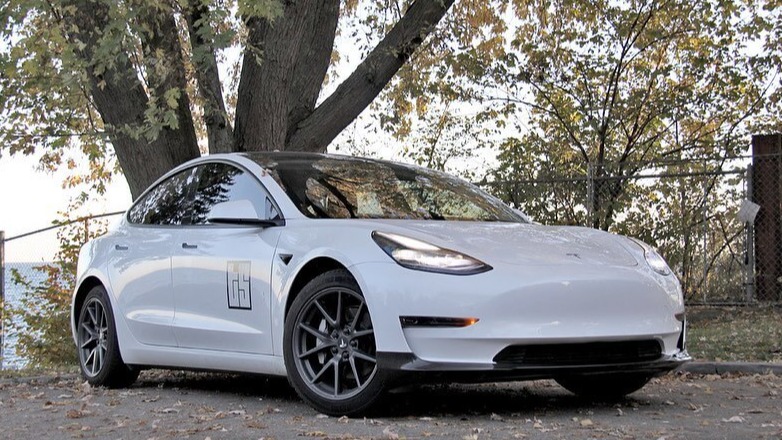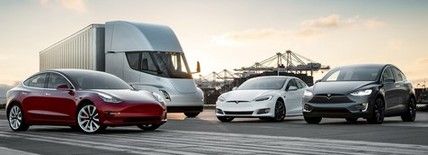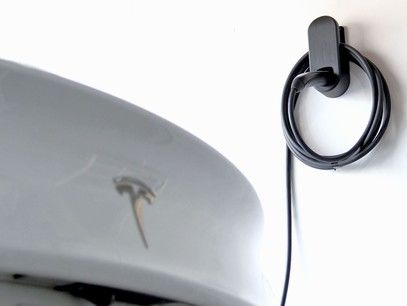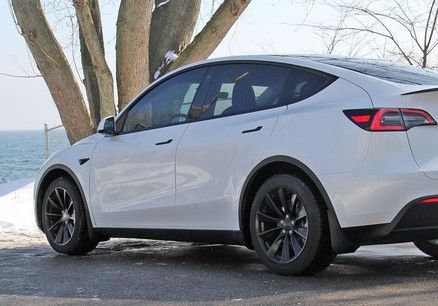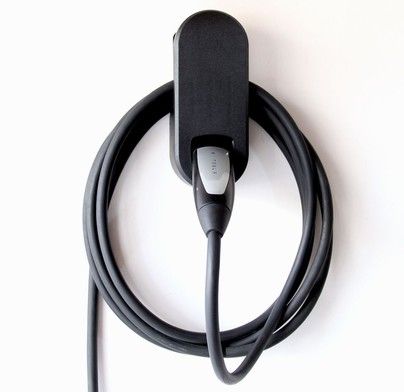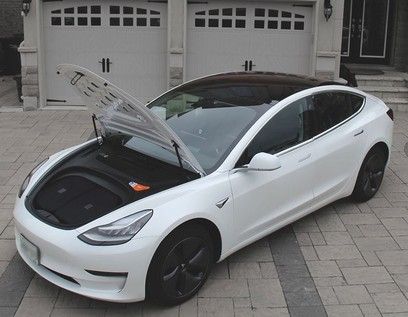Electric vehicles have become increasingly popular in North America thanks to rising gas prices and a push to go green for the next generation. But knowing when and how to charge an EV is very important, especially for first time EV drivers.
So if you’ve recently purchased an electric vehicle and are looking for the best home EV charger then you’ve come to the right place. We’ll give you a full breakdown of the best electric vehicle chargers to help you decide which one best suits your needs, budget, and compatibility for your home.
What is an EV Charger?
An EV charger, also known as an electric vehicle charger or an electric car charger, is a handheld device connected to an electrical outlet that is used to recharge the battery of an electric vehicle.
There are three types of EV chargers on the market: Level 1, Level 2, and Level 3 fast chargers, that charge an EV at different speeds to transmit energy into the battery.
All electric vehicles sold in North America, aside from Tesla, use the same SAE J1772 plug to charge an EV battery with a Level 2 charger at home or public charging station. Tesla vehicles however come with an adaptor to make them capable with nearly any EV charger.
How does EV charging work?
The energy that’s stored in an electric vehicle is depleted as the car is driven, and that rate can vary depending on how fast one drives and if any additional weight is being carried or towed. When plugged into your electric vehicle’s battery charging point, an EV charging device will use an electrical current via a charging cable to replenish a depleted battery and restore the EV's driving range.
Charging my Electric Vehicle
How do I charge my EV away from home?
Charging an electric vehicle is often the biggest concern for new car owners, and determining where and how often to charge your EV can depend on its driving range and your own driving habits.
Charging Apps such as ChargePoint help new EV drivers find the closest public charging stations in their area, while Tesla's navigation system easily maps out all of the Tesla charging stations in Canada and the US for its drivers.
As EV technology evolves, so will the battery life and the infrastructure for public EV charging. In both Canada and the US, provincial, state, and federal governments are working with the private sector to build at least 100,000 EV charging stations by the year 2030 in order to support the 22 million electric vehicles that are expected to be on the road in the US alone, as projected by the Edison Electric Institute.
As of January 2022, Canada has 15,000 public or semi-private charging stations across the country, with an additional 19,000 expected to be up and running by 2025.
Until then, finding the right EV charger for your home and lifestyle is critical to driving your electric car with some peace of mind.
How to Charge an EV at Home
A home EV charger is similar to one found at a public charging station, but instead can be plugged into an electrical outlet in your home’s garage or a panel along the side of your home. The electrical power supply in your home however will be much lower than a public EV charging station, maxing out between 120 volts to 240 volts, making the charging time at home much slower.
But we’ll cover the different charging levels and the best home EV charging options available on the market a little later on to help you safely and quickly charge your electric vehicle at home.
Note that if you live in a condo, it can be very costly to have an EV charger installed in your designated parking spot as it will require both approval and cooperation from the building’s management to complete the installation process. It is typically not recommended unless you have the patience and a large budget.
Can I charge an EV in the rain?
Yes, it is safe to charge most newly built electric vehicles in the rain as auto manufacturers have factored in the need for protection against rain and water intrusion, as well as dust, into the design of the battery and its charging point.
The same can be said for public charging stations that have safety measures in place to ensure their charging cables are safe to use in the rain. The charging device and EV will communicate when first plugged in, and ensure it is safe to proceed before beginning a flow of energy.
How long does it take to charge an electric vehicle?
The time required to fully charge your electric vehicle’s depleted battery depends on the battery size and maximum driving range of the vehicle, as well as the type of EV charger being used.
To calculate the total charging time for your specific electric car, you'll need to divide the battery size by the EV's charger capacity eg. 150-kWh battery / 10-kW charger equals approximately 15 hours to fully charge a depleted EV battery.
A level 1 charger connected to a typical NEMA 5-15 120V outlet will charge your electric vehicle’s fully depleted battery in about 35-50 hours.
A Level 2 charger connected to a NEMA 14-50 240V outlet can fully charge your electric vehicle in about 5-8 hours.
A Level 3 fast charger can fully charge your EV’s battery in about 30-60 minutes. These are more commonly found at Tesla supercharging stations and are very rare for home use as they require too much power and are very expensive to install.
How many kWh are needed to charge an EV?
The amount of kWh, also known as a kilowatt hour of energy, needed to charge an EV is based on the battery size of your particular electric vehicle and how depleted the battery is at a given time.
When driving at a steady, constant speed, an EV typically uses around 1 kWh of energy for every 5 to 6 km, or 3 to 4 miles, of driving distance. In other words, a standard EV requires about 50 - 60 kWh per 100 km, or 30 - 40 kWh per 100 miles of driving.
Your EV might have a 100 kWh battery when fully charged, so if completely depleted, it’ll require 100 kWh to be fully charged again.
How much does it cost to charge an EV?
The cost to fully charge your EV will depend on its battery size and maximum driving range, as well as the electricity rates in your area at a specific time of day.
Select EVs such as new Tesla models often offer a base driving range of free charging per year at Tesla charging stations. Once you pass your charging limit, it typically costs around 25 cents per kWh to charge at a public charging station. So if your 100 kWh EV battery is fully depleted, it would cost about $25 to fully charge. Again the electricity rates can vary from one charging station to another, based on the rates in that given area at that time of day.
When using a Level 1 or Level 2 EV charger at home, the electricity rates will be far cheaper in most areas, especially if you’re charging during off-peak hours when demand is lower such as overnight.
Electricity rates at home will of course vary by area, but are generally in the range of 5 cents to 10 cents per kWh. So assuming your EV has a 100 kWh battery, it would cost somewhere between $5 to $10 to fully charge when using your home EV Level 2 charger overnight.
Electric Vehicle Charging Levels
What is a Level 1 EV Charger?
A Level 1 EV Charger is the most basic type of charging station for home use, that utilizes the typical home electrical current, connecting to a 120 volt power outlet with a three prong plug.
For new EV drivers that have access to a public charging station at their workplace, or very close to home, Level 1 EV chargers do offer a low cost approach to charging their EV with a few extra miles of driving range overnight.
However, the charging time with a Level 1 charger is incredibly slow, requiring around 35 to 50 hours to fully charge a depleted EV battery. This makes it very inconvenient for home owners who drive their EV on a daily basis, forcing them to spend time at a public charging station multiple times a week.
It’s only recommended to rely on a Level 1 charger if you’re a driver of a plug-in hybrid electric vehicle, also known as a PHEV.
What is a Level 2 EV Charger?
A Level 2 EV Charger is the most efficient and widely used charger for home EV charging stations today. Level 2 chargers use a 240 volt circuit, the same used for most home electric clothes dryers.
Since most home garages are not equipped with the same multi-pronged outlet as a laundry room, most electric vehicle owners will hire a licensed electrician to run a 240 volt circuit in the garage, such as a NEMA 14-50 outlet. From there, you can choose to either have the Level 2 EV charging station hardwired into that circuit, or plug a portable EV charger into a new outlet.
This of course is much more expensive than using a simple Level 1 EV charger, however, a Level 2 charger allows you to fully charge your EV's battery within 5 to 6 hours on average, making it well worth the added expense and time saved, as long as your home's electrical system can manage the power required to charge.
As noted earlier, EVs sold in North America, aside from Tesla, use the same SAE J1772 plug to charge the battery with a Level 2 charger at home. Tesla vehicles however do come with an adaptor to make them capable with nearly any Level 2 EV charger.
What is a Level 3 EV Fast Charger?
The most advanced type of EV Charger is the Level 3 Charger, also known as a Fast Charger, which enables DC fast charging to fully charge a depleted EV battery in about one hour.
How much is an EV Fast Charger?
EV fast chargers are still quite expensive, costing up to $25,000 - $50,000 or more for complete installation, and are designed more so for commercial use.
It is less common to see a Level 3 EV Charger installed for home use as most residential electrical grids and home panels will not support its use. It does offer a look into the future of home EV charging but we’re likely still years away from this coming to fruition.
What are the best electric vehicle chargers?
There are many options available on the market for home EV chargers, with a wide price range and suit of features offered to EV drivers.
Assuming they cover the necessary features and benefits noted below, much of the purchasing decision will come down to how often you drive your electric vehicle and whether the advanced features of the most expensive Level 2 EV chargers are useful for you, your budget, and most importantly, your time.
What are common features of the best home EV chargers on the market?
Some common features offered by the best electric vehicle chargers include:
1) Fast Charging: Connection to a high current outlet, in the 30-50 amp range, to quickly charge your EV battery.
2) Cable Length and Holster: A cable length between 16-24 feet to give you ample charging distance from the outlet in your garage to your vehicle. Some EV charging models also include a holster to hold the cable and connector to help avoid clutter in the garage and remove a tripping hazard.
3) Safety Standards: Strong safety certifications and short circuit protection with Energy Star certification in order to safely charge your EV battery without harming your electrical panel or causing frequent short circuiting.
4) Portability: For home owners that do not want to hardwire their EV charger, a portable Level 2 charger should be a manageable weight and size to safely store in your EV’s trunk for use at a secondary location such as a cottage or future home.
We’ve narrowed down the best Level 2 EV chargers for your electric vehicle based on their compatibility, durability, functionality, and portability.
ChargePoint: Level 2 Home Flex EV Charger
- A NEMA 14-50 240 Volt charging station with flexible amperage setting from 16 to 50 amps to accommodate your home’s electrical capabilities. This allows you to charge an EV up to 37 miles of range in one hour, or up to 9 times faster than a typical Level 1 EV charger using a standard wall outlet.
- Compatibility: Its universal J1772 connector works for Tesla models and most other popular electrical cars such as the Toyota Prius Prime, BMW i3, Chevy Volt and Bolt, Nissan Leaf, Hyundai Kona and Ioniq, etc.
- Charging Cable: Its 23 foot or 7 meter charging cable and NEMA 3R weatherproof enclosure making it ideal for most indoor and outdoor settings.
- Portability: Very portable if needed to carry to another location such as a cottage or new home.
- Certification: Energy Star certified and three years of customer support.
- Home Installation: Simple process for a licensed electrician to install indoors or outdoors. Plug-in installation with NEMA 6-50 or 14-50 outlets requires circuits rated 50A in Canada.
- The ChargePoint app conveniently allows you to schedule your charging time to when the electricity rates are cheapest in your area and track your charging data on your phone.
- Price Range: $950 to $1,000 puts it on the higher end, but with a great reputation and thousands of positive customer reviews, this EV charger is worth the added expense if you can make it work with your budget.
Bosch: EV600 Series Level 2 Wall Charger
- NEMA 6-50 240 Volt charging station with flexible amperage setting from 30 to 40 amps to accommodate your home’s electrical capabilities. This allows you to charge an EV between 28 - 30 miles of range in one hour at 40 amp, or up to 8 times faster than a typical Level 1 EV charger using a standard wall outlet.
- Compatibility: Its universal J1772 connector works for Tesla models and most other popular electric cars sold in North America, similar to the ChargePoint EV charger.
- Charging Cable: Its 18 foot or 5.5 meter charging cable and NEMA 3R aluminum cast with a robust enclosure are safe indoor and outdoor settings.
- Portability: Also portable if needed to carry to another location such as a cottage or new home.
- Certification: UL full tested and certified. IP67 (water resistant), fire resistant, over current, over voltage, under voltage, ground fault, and over temperature protections. Incudes self-monitoring and power outage recovery. Built in GFCI. Three years of customer support.
- Home Installation: Also a simple process for a licensed electrician to install indoors or outdoors. Plug-in installation with NEMA 6-50 outlets requires circuits rated 50A in Canada.
- Price Range: $700 to $1000 depending on which options you select, makes it an affordable home EV charging option. With a very good reputation and hundreds of positive customer reviews, this Bosch EV charger is a great choice for a new EV driver.
How to Install an EV Charger at Home
The installation process for a home EV charging station may seem daunting, but most can be completed with the help of a licensed electrician.
How much does it cost to install an EV charger at home?
The cost to install an EV charger at home will depend on:
- EV Charging level such as Level 1 or Level 2;
- Your home’s current electrical capacity;
- Accessibility of your electrical panels inside your garage or external wall for those homes without a garage;
- Whether you plan to hardwire the charger into your home’s garage or along the side of the house versus plugging it into an available outlet.
If you’re prepared to only charge enough to add a few miles of range to your EV in a given day, then the cost for installation will be close to $0 with a Level 1 EV charger. Most electric vehicles sold in North America are equipped with a standard three prong plug that utilizes the typical home electrical current, connecting to a standard 120 volt power outlet, making installation as simple as plugging your charging cable into the outlet.
If not, a Level 1 EV charging cable will cost you around $200 - $300. At which point you’ll just need to monitor your electricity rates per hour of charging at home, and be prepared to charge your EV much more frequently at a public charging station, where kWh rates will be much higher.
In order to install a Level 2 EV charger in your home, it will typically cost between $500 to $1,000 for the charging station itself, plus an additional $500 to $1,000 to cover electrical wiring costs and labour if a 240 volt outlet is not readily available in your garage.
Do I need an electrician to install my EV charger?
A Level 1 EV charger does not require the assistance of a licensed electrician as you can simply plug it into a standard NEMA 5-15 120V outlet. However this is only useful if you’re looking to add a few miles of driving range to your vehicle overnight, or if you do not drive frequently.
Installing a Level 2 EV charger at home typically requires the assistance of an electrician unless you have a thorough understanding of your home’s electrical panels and capacity, or if your home was newly constructed with a 240 volt outlet in the garage. Even then, it is highly recommended that you contact a licensed electrician to assist with any hardwiring or if a new 240V outlet is required in your garage or exterior of your home. Thankfully, there are tax incentives available in Canada and the US for this installation and any associated construction that could be required in your home.
How do I claim an EV charger tax credit?
As part of a Green initiative to encourage drivers to purchase electric cars and move away from gas-powered vehicles, many Canadian provinces and American states now offer a tax rebate for single family home EV chargers and the installation completed by a licensed electrician.
Rebates may vary from province to province and state to state so you’ll need to look up the available tax credits offered in your area.
Some general eligibility requirements and available ev charger tax credits to claim in most jurisdictions include:
- An EV charger that is wall mounted at the electrical service address provided in your rebate application.
- The EV Charger was approved for sale and use in Canada or the US and includes certain safety certifications such as CSA, ULC, CUL, cETL, or cQPS.
- An example of an EV charger that would typically be eligible for a tax credit would be a plug-in or hardwired Level 2 charger with 240 volts, and a standard universal J1772 connector.
- The purchase cost of the new EV charger and its proof of purchase. Leased, used or refurbished chargers are typically excluded.
- Construction and labour costs for EV installation by a licensed electrician.
- Cost of an electrical permit and design required for the charging station. If you hire a licensed contractor and/or electrician, then they’ll typically apply for the permit on your behalf.
- The installation invoice showing proof of payment and the itemized installation cost.

